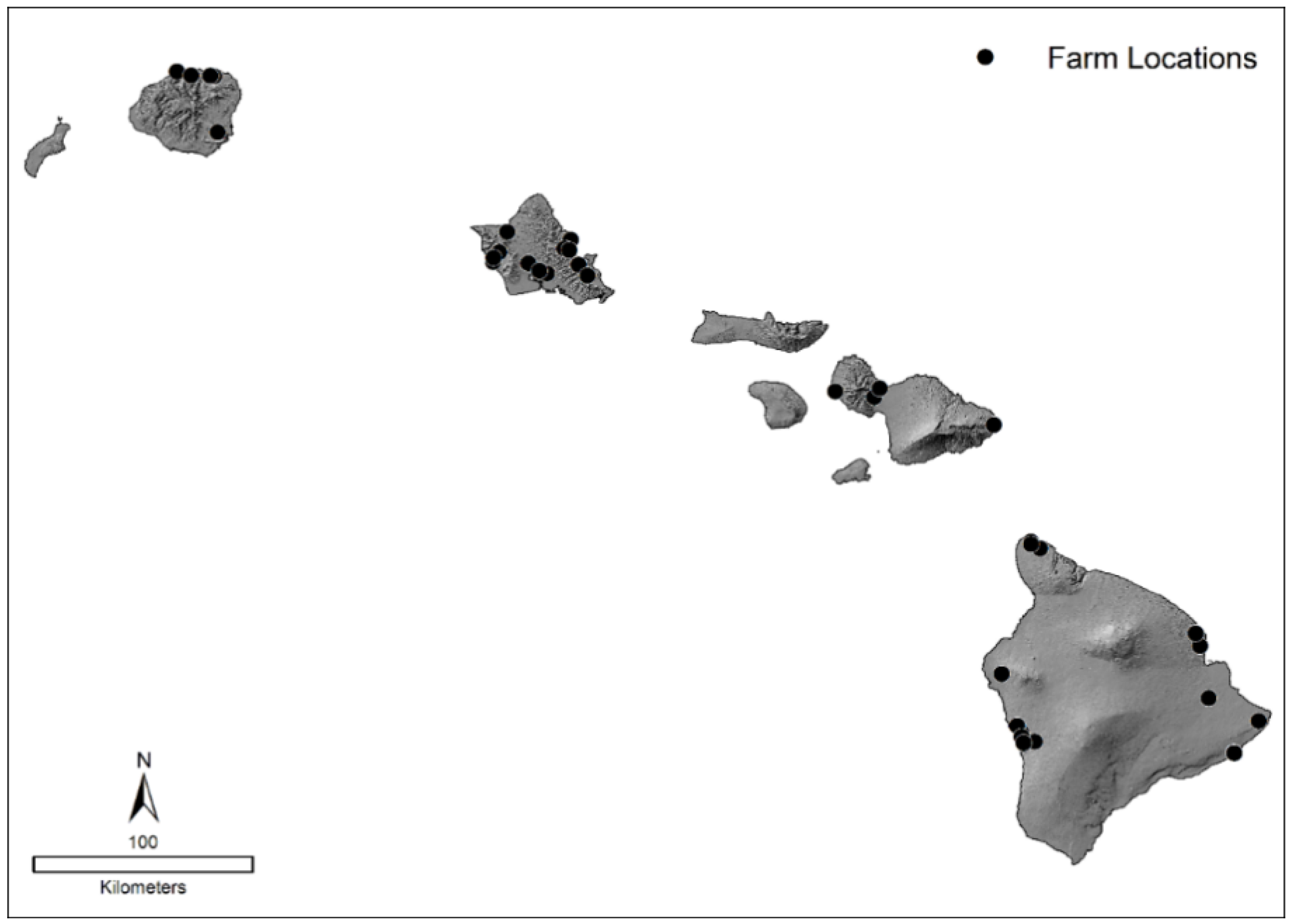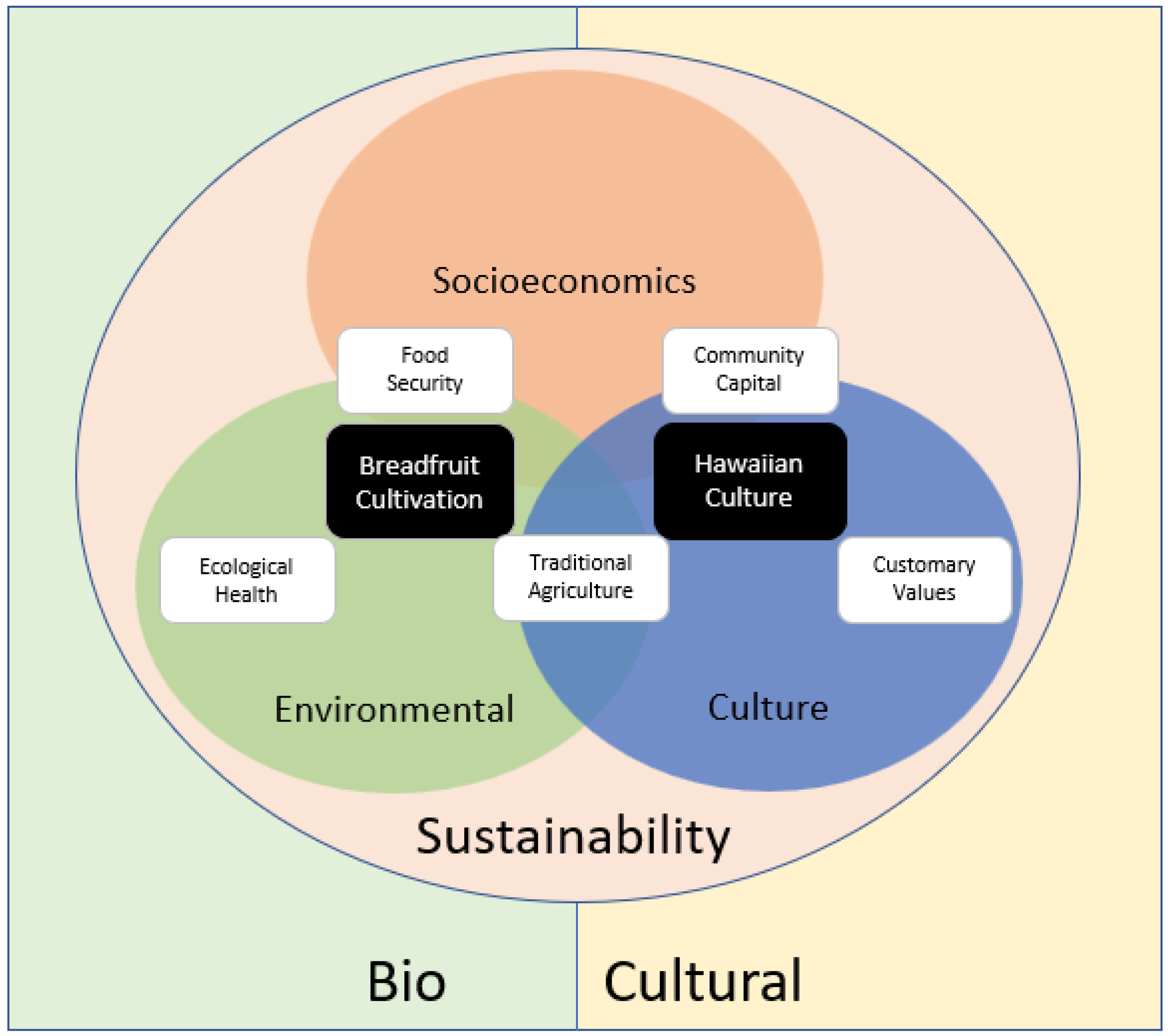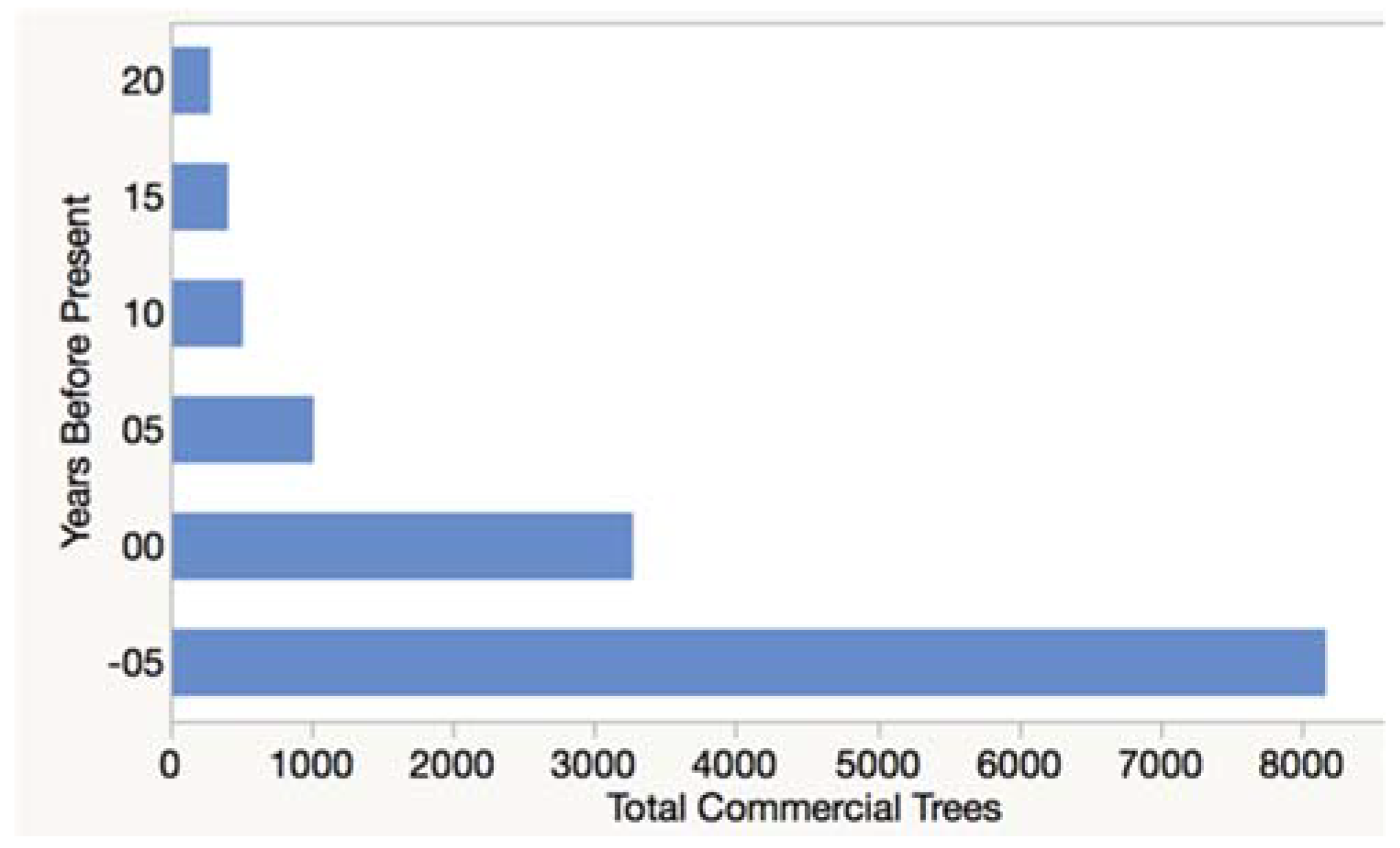The Role of Breadfruit in Biocultural Restoration and Sustainability in Hawai‘i
Abstract
1. Introduction
1.1. Traditional Breadfruit Cultivation in Hawai‘i
1.2. Traditional Importance of Breadfruit in Hawai‘i
1.3. Loss of Traditional Food Systems
1.4. Resurgence for Local Food and Breadfruit in Hawai‘i
2. Materials and Methods
3. Results
3.1. Customary Values
3.2. Traditional Agricultural Practices
3.3. Community (Social) Capital
3.4. Food Security
3.5. Ecological Health
“Is it a superfood?! It’s definitely a tree of abundance. I always joke around it’s like a tree of life. Hundreds of pounds. With really minimal [inputs], I fertilize them once in a while but other than that they just go. It’s definitely a tree that gives plenty. It’s suited for here. I learned to not quite force anything. There’s so many trees I’ve tried to make grow on a farm. It’s the ones from here that can endure.”
4. Conclusions
“We have started calling breadfruit a ‘solutionary’ food. There are so many problems with our food system. I mean there is the health and nutrition, there are the environmental issues, there is food justice and food security. And there is just the loss of identity and enjoyment of food. So many issues that need to be fixed. We need a revolution of the way we deal with food. What is amazing about breadfruit is that it hits all of these. I mean, more than any other food I can think of. That it is a tree. That it is embedded in the culture. That it is a nutritious staple. It really has the potential to be a solution to many problems in our food system. So, it is the revolutionary solution that we need...‘solutionary.’ Get it?”
Author Contributions
Funding
Acknowledgments
Conflicts of Interest
Appendix A
|
Interview Questions
|
References
- Chirico, J.; Farley, G.S. Thinking Like an Island: Navigating a Sustainable Future in Hawaii; University of Hawaii Press: Honolulu, HI, USA, 2015. [Google Scholar]
- Böhringer, C.; Jochem, P.E. Measuring the Immeasurable—A Survey of Sustainability Indices. Ecol. Econ. 2007, 63, 1–8. [Google Scholar] [CrossRef]
- Maffi, L.; Pretty, J.; Ball, A.S.; Benton, T.S.; Lee, G.J.; Orrm, D.R.; Pfeffer, D.; Ward, M.J. Biocultural Diversity and Sustainability. In The Sage Handbook of Environment and Society; Sage Publications: Thousand Oaks, CA, USA, 2007. [Google Scholar]
- Pretty, J.; Adams, B.; Berkes, F.; De Athayde, S.F.; Dudley, N.; Hunn, E.; Sterling, E. The Intersection of Biological Diversity and Cultural Diversity: Towards Integration. Conserv. Soc. 2009, 7, 100–112. [Google Scholar]
- Barthel, S.; Crumley, C.; Svedin, U. Bio-Cultural Refugia—Safeguarding Diversity of Practices for Food Security and Biodiversity. Glob. Environ. Chang. 2013, 23, 1142–1152. [Google Scholar] [CrossRef]
- Pretty, J. Interdisciplinary Progress in Approaches to Address Social-Ecological and Ecocultural Systems. Environ. Conserv. 2011, 38, 127–139. [Google Scholar] [CrossRef]
- Vaughan, M.B.; Ayers, A.L. Customary Access: Sustaining Local Control of Fishing and Food on Kauai’s North Shore. Food Cult. Soc. 2016, 19, 517–538. [Google Scholar] [CrossRef]
- Wehi, P.M.; Lord, J.M. Importance of Including Cultural Practices in Ecological Restoration. Conserv. Biol. 2017, 31, 1109–1118. [Google Scholar] [CrossRef] [PubMed]
- Godfrey, H.C.; Beddington, J.R.; Crute, I.R.; Haddad, L.; Muir, J.F.; Pretty, J.; Robinson, S.; Thomas, S.M.; Toulmin, C. Food Security: The Challenge Of Feeding 9 Billion People. Science 2010, 327, 812–819. [Google Scholar] [CrossRef] [PubMed]
- Zerega, N.; Wiesner-hanks, T.; Ragone, D. Diversity in the Breadfruit Complex (Artocarpus, Moraceae): Genetic Characterization of Critical Germplasm. Tree Genet. Genomes 2015, 11, 1–26. [Google Scholar] [CrossRef]
- Meilleur, B.A.; Jones, R.R.; Tichenal, C.A.; Huang, A.S. Hawaiian Breadfruit: Ethnobotany, Nutrition, and Human Ecology; College of Tropical Agriculture and Human Resources, University of Hawaii at Manoa: Honolulu, HI, USA, 2004. [Google Scholar]
- McCoy, M.D.; Graves, M.W.; Murakami, G. Introduction of Breadfruit (Artocarpus altilis) to the Hawaiian Islands. Econ. Bot. 2010, 64, 374–381. [Google Scholar] [CrossRef]
- Lincoln, N.K.; Vitousek, P.M. Indigenous Polynesian Agriculture in Hawaii; Oxford University Press: Evans Road Cary, NC, USA, 2017. [Google Scholar]
- Handy, E.S.; Handy, E.G.; Pukui, M.K. Native Planters in Old Hawai‘i: Their Life, Lore, and Environment; Bishop Museum Press: Honolulu, HI, USA, 1972. [Google Scholar]
- Lincoln, N.K.; Ragone, D.; Zerega, N.; Roberts-Nkrumah, L.B.; Merlin, M.; Jones, A.M. Grow Us Our Daily Bread: A Review of Breadfruit Cultivation in Traditional and Contemporary Systems. Hortic. Rev. 2018, 46, 299–384. [Google Scholar]
- Lincoln, N.; Ladefoged, T. Agroecology of Pre-Contact Hawaiian Dryland Farming: The Spatial Extent, Yield and Social Impact of Hawaiian Breadfruit Groves in Kona, Hawai’i. J. Archaeol. Sci. 2014, 49, 192–202. [Google Scholar] [CrossRef]
- Allen, M.S. Bet-Hedging Strategies, Agricultural Change, and Unpredictable Environments: Historical Development of Dryland Agriculture in Kona, Hawaii. J. Anthropol. Archaeol. 2004, 23, 196–224. [Google Scholar] [CrossRef]
- Kurashima, N.; Kirch, P.V. Geospatial Modeling of Pre-Contact Hawaiian Production Systems on Molokai Island, Hawaiian Islands. J. Archaeol. Sci. 2011, 38, 3662–3674. [Google Scholar] [CrossRef]
- Newman, T.S. Hawaiian Agricultural Zones Circa A.D. 1832: An Ethnohistory Study. Ethnohistory 1971, 18, 335–351. [Google Scholar] [CrossRef]
- Kelly, M. Na Mala o Kona: Gardens of Kona; Bernice P. Bishop Museum: Honolulu, HI, USA, 1983. [Google Scholar]
- Whistler, W.A. Plants of the Canoe People; National Tropical Botanical Gardens: Kalaheo, HI, USA, 2009. [Google Scholar]
- Winter, K.B.; Lincoln, N.K.; Berkes, F. The Social-Ecological Keystone Concept: A Quantifiable Metaphor for Understanding the Structure, Function, and Resilience of a Biocultural System. Sustainability 2018, 10, 3294. [Google Scholar] [CrossRef]
- Jones, A.M.P.; Murch, S.J.; Ragone, D. Diversity of Breadfruit (Artocarpus altilis, Moraceae) Seasonality: A Resource for Year-Round Nutrition. Econ. Bot. 2010, 64, 340–351. [Google Scholar] [CrossRef]
- O’Connor, K. The Hawaiian Luau. Food Cult. Soc. 2015, 11, 149–172. [Google Scholar] [CrossRef]
- Turi, C.E.; Liu, Y.; Ragone, D.; Murch, S.J. Trends in Food Science & Technology Breadfruit (Artocarpus altilis and Hybrids): A Traditional Crop with the Potential to Prevent Hunger and Mitigate Diabetes in Oceania. Trends Food Sci. Technol. 2015, 45, 264–272. [Google Scholar]
- MacCaughey, V. The Genus Artocarpus in Hawaii. Torreya 1917, 17, 33–49. [Google Scholar]
- Krauss, B.H. Ethnobotany of Hawaii; Department of Botany, University of Hawaii: Honolulu, HI, USA, 1986. [Google Scholar]
- Jones, A.M.P.; Klun, J.A.; Cantrell, C.L.; Ragone, D.; Chauhan, K.R.; Brown, P.N.; Murch, S.J. Isolation and Identification of Mosquito (Aedes aegypti) Biting Deterrent Fatty Acids from Male Inflorescences of Breadfruit (Artocarpus altilis (Parkinson) Fosberg). Agric. Food Chem. 2012, 60, 3867–3873. [Google Scholar] [CrossRef] [PubMed]
- Brookfield, H. Intensification Intensified: Prehistoric Intensive Agriculture in the Tropics. Archaeol. Ocean. 1986, 21, 177–180. [Google Scholar] [CrossRef]
- Cachola-Abad, C.K. An Analysis of Hawaiian Oral Traditions: Descriptions and Explanations of the Evolution of Hawaiian Socio-Political Complexity; University of Hawaii at Manoa: Honolulu, HI, USA, 2000. [Google Scholar]
- Kirch, P.V. Hawaii as a Model System for Human Ecodynamics. Am. Anthropol. 2007, 109, 8–26. [Google Scholar] [CrossRef]
- Kirch, P.V. The Evolution of Sociopolitical Complexity in Prehistoric Hawaii: An Assessment of the Archaeological Evidence. J. World Prehistory 1990, 4, 311–345. [Google Scholar] [CrossRef]
- Kirch, P.V.; Zimmerman, K.S. Roots of Conflict; School for Advanced Research Press: Santa Fe, NM, USA, 2011. [Google Scholar]
- Malo, D. Concerning the Makahiki. In Hawaiian Antiquities; Malo, D., Ed.; Bishop Museum Press: Honolulu, HI, USA, 1951. [Google Scholar]
- Handy, E.S.C.; Emory, K.P.; Bryan, E.; Buck, P.H.; Wise, J. Feasts and Holidays. In Ancient Hawaiian Civilization Revised Edition; Charles, E., Ed.; Turtle Company: Ibaraki, Japan, 1965; pp. 62–68. [Google Scholar]
- Kirch, P.V. Cultural Adaptation and Ecology in Western Polynesia: An Ethnoarchaeological Study. In Indigenous Crops and Cropping Systems Seminar; Tropical Plant and Soil Sciences, University of Hawaii: Honolulu, HI, USA, 2017. [Google Scholar]
- Beckwith, M.W. Hawaiian Mythology; University of Hawaii Press: Honolulu, HI, USA, 1940. [Google Scholar]
- Pukui, M.K. ‘Ōlelo Nō‘eau: Hawaiian Proverbs and Poetical Sayings; Bishop Museum Press: Honolulu, HI, USA, 1983; Volume 71. [Google Scholar]
- Stannard, D.E. Before the Horror: The Population of Hawai‘i on the Eve of Western Contact; University of Hawaii Press: Honolulu, HI, USA, 1994. [Google Scholar]
- Swanson, D.A. The Number of Native Hawaiians and Part Hawaiians. In Hawai’i, 1778 to 1900: Demographic Estimates by Age, with Discussion; University of California: Riverside, CA, USA, 2015. [Google Scholar]
- Loke, M.; Leung, P. Hawaii’s Food Consumption and Supply Sources: Benchmark Estimates and Measurement Issues. Agric. Food Econ. 2013, 1, 1–18. [Google Scholar] [CrossRef]
- Union of Concerned Scientists 50-State Food System Scorecard. Available online: https://www.ucsusa.org/food-agriculture/food-system-scorecard#.W6hw1GhKjIU (accessed on 1 June 2018).
- Brower, A. Hawaii: GMO Ground Zero—Seeds of Occupation, Seeds of Possibility. Ph.D. Thesis, University of Auckland, Auckland, New Zealand, 2016. [Google Scholar]
- Mostafanezhad, M.S. Is Farming Sexy? Agro-Food Initiatives and the Contested Value of Agriculture in Post Plantation Hawaii. Geoforum 2018, 97, 227–234. [Google Scholar] [CrossRef]
- Ragone, D.; Elevitch, C.; Dean, A. Revitalizing Breadfruit in Hawaii—A Model for Encouraging the Cultivation and Use of Breadfruit in the Tropics. Trop. Agric. 2016, 93, 213–224. [Google Scholar]
- Ragone, D.; Cavaletto, C. Sensory Evaluation of Fruit Quality and Nutritional Composition of 20 Breadfruit (Artocarpus; Moraceae) Cultivars. Econ. Bot. 2006, 60, 335–346. [Google Scholar] [CrossRef]
- Bremmer, L.; Delevaux, J.M.; Leary, J.J.K.; Cox, L.; Oleson, K.L. Opportunities and Strategies to Incorporate Ecosystem Services Knowledge and Decision Support Tools into Planning and Decision Making in Hawaii. Environ. Manag. 2015, 55, 884–889. [Google Scholar] [CrossRef] [PubMed]
- Lincoln, N.K.; Ardoin, N.M. Cultivating Values: Environmental Values and Sense of Place as Correlates of Sustainable Agricultural Practices. Agric. Hum. Values 2016, 33, 389–401. [Google Scholar] [CrossRef]
- Lincoln, N.K.; Ardoin, N. Farmer Typology in South Kona, Hawaii: Who‘s Farming, How, and Why? Food Cult. Soc. 2016, 19. [Google Scholar] [CrossRef]
- Perroy, R.L.; Melrose, J.; Cares, S. The Evolving Agricultural Landscape of Post-Plantation Hawaii. Appl. Geogr. 2016, 76, 154–162. [Google Scholar] [CrossRef]
- 2012 Census of Agriculture, State Profile, Hawaii. Available online: https://www.agcensus.usda.gov/Publications/2012/Online_Resources/County_Profiles/Hawaii/cp99015.pdf (accessed on 22 August 2018).
- 2017 State Agriculture Overview: Hawaii. Available online: https: //www.nass.usda.gov/Quick_Stats/Ag_Overview/stateOverview.php?state=HAWAII (accessed on 22 August 2018).
- Chun, M.C. Welina: Traditional and Contemporary Ways of Welcome and Hospitality. In No Na Māmo: Traditional and Contemporary Hawaiian Beliefs and Practices; Curriculum Research & Development Group, College of Education, University of Hawaii: Honolulu, HI, USA, 2011; pp. 14–45. [Google Scholar]
- Abbott, I.A. Lā‘au Hawai‘i: Traditional Hawaiian Uses of Plants; Bishop Museum Press: Honolulu, HI, USA, 1992. [Google Scholar]
- Vaughan, M.B.; Vitousek, P.M. Mahele: Sustaining Communities through Small Scale Inshore Fishery Catch and Sharing Networks. Pac. Sci. 2013, 67, 329–344. [Google Scholar] [CrossRef]
- Gao, J.; Barbieri, C.; Valdivia, C. A Socio-Demographic Examination of the Perceived Benefits of Agroforestry. Agrofor. Syst. 2014, 88, 301–309. [Google Scholar] [CrossRef]
- Garret, H.E.; Rietvald, W.J.; Fisher, R.F. North American Agroforestry: An Integrated Science and Practice; American Society of Agronomy, Inc.: Madison, WI, USA, 2000. [Google Scholar]
- Isabell, F.; Adler, P.R.; Eisenhauer, N.; Fornara, D.; Kimmel, K.; Kremen, C.; Letourneau, D.K.; Leibman, M.; Polley, H.W.; Quijas, S.; et al. Benefits of Increasing Plant Diversity in Sustainable Agroecosystems. J. Ecol. 2017, 105, 871–879. [Google Scholar] [CrossRef]




| Attribute | Agricultural Producers | Non-Profits | ||||
|---|---|---|---|---|---|---|
| n | Average | Std Err | n | Average | Std Err | |
| Size of farm (acres) | 36 | 27 | 10 | 7 | 409 | 339 |
| Area in breadfruit | 33 | 3.4 | 1.2 | 7 | 0.6 | 0.2 |
| Number of trees | 33 | 69 | 24 | 7 | 38 | 14 |
| Age of trees | 28 | 14 | 2.8 | 7 | 12 | 4.6 |
| Production per tree (lbs.) | 15 | 101 | 39 | 4 | 152 | 68 |
| Practice (n = 38) | % Apply |
|---|---|
| Fertilizer | 25% |
| Compost | 44% |
| Mulch | 54% |
| Cover Crops | 5% |
| Intercropped | 67% |
| Pesticides | 7% |
| Herbicides | 21% |
| Irrigation | 28% |
© 2018 by the authors. Licensee MDPI, Basel, Switzerland. This article is an open access article distributed under the terms and conditions of the Creative Commons Attribution (CC BY) license (http://creativecommons.org/licenses/by/4.0/).
Share and Cite
Langston, B.J.; Lincoln, N.K. The Role of Breadfruit in Biocultural Restoration and Sustainability in Hawai‘i. Sustainability 2018, 10, 3965. https://doi.org/10.3390/su10113965
Langston BJ, Lincoln NK. The Role of Breadfruit in Biocultural Restoration and Sustainability in Hawai‘i. Sustainability. 2018; 10(11):3965. https://doi.org/10.3390/su10113965
Chicago/Turabian StyleLangston, Blaire J., and Noa Kekuewa Lincoln. 2018. "The Role of Breadfruit in Biocultural Restoration and Sustainability in Hawai‘i" Sustainability 10, no. 11: 3965. https://doi.org/10.3390/su10113965
APA StyleLangston, B. J., & Lincoln, N. K. (2018). The Role of Breadfruit in Biocultural Restoration and Sustainability in Hawai‘i. Sustainability, 10(11), 3965. https://doi.org/10.3390/su10113965






